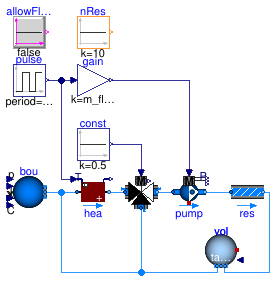Buildings.Fluid.Examples
Example models integrating multiple components
Information
This package contains advanced examples for the use of models that can be found in Buildings.Fluid.
Extends from Modelica.Icons.ExamplesPackage (Icon for packages containing runnable examples).
Package Content
| Name | Description |
|---|---|
| System demonstrating impact of allowFlowReversal on number/size of non-linear systems | |
| Package of examples that demonstrate computation speed performance |
 Buildings.Fluid.Examples.ResistanceVolumeFlowReversal
Buildings.Fluid.Examples.ResistanceVolumeFlowReversal
System demonstrating impact of allowFlowReversal on number/size of non-linear systems

Information
This model demonstrates the impact of the allowFlowReversal parameter on the size
of nonlinear systems of equations. The user can change the parameter value in the allowFlowReversal
block and rerun the simulation. The results are also demonstrated below for nRes.k = 10,
which is the number of parallel branches containing one pressure drop element and one mixing volume each.
This model was created to demonstrate the influence of a new implementation of
Buildings.Fluid.Interfaces.ConservationEquation.
The old implementation used the actualStream() function
whereas the new implementation uses the semiLinear()
function. This change allows Dymola to exploit knowledge about the min and max attributes
of m_flow.
When Dymola knows in which way the medium will flow, nonlinear systems can be simplified or completely removed.
This is illustrated by the results below.
See issue 216 for a discussion.
Note that Dymola 2015FD01 can only reliably solve the last case. For the other two cases the Newton solver of the nonlinear system does not converge.
These results were generated using Dymola 2015FD01 64 bit on Ubuntu 14.04
and with Evaluate=false.
ResistanceVolumeFlowReversal = true
Sizes of nonlinear systems of equations: {6, 11, 56}
Sizes after manipulation of the nonlinear systems: {1, 9, 12}
ResistanceVolumeFlowReversal = false
Old implementation
Sizes of nonlinear systems of equations: {6, 11, 44}
Sizes after manipulation of the nonlinear systems: {1, 9, 11}
New implementation
Sizes of nonlinear systems of equations: {6, 11, 4}
Sizes after manipulation of the nonlinear systems: {1, 9, 1}
Extends from Modelica.Icons.Example (Icon for runnable examples).
Parameters
| Type | Name | Default | Description |
|---|---|---|---|
| Real | m_flow_nominal | 0.1 | Gain value multiplied with input signal |
